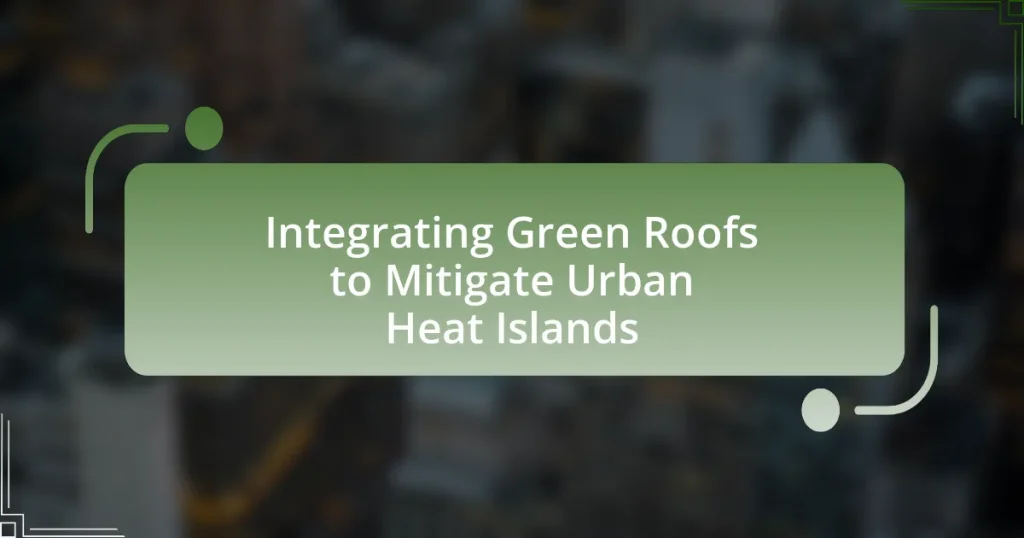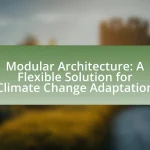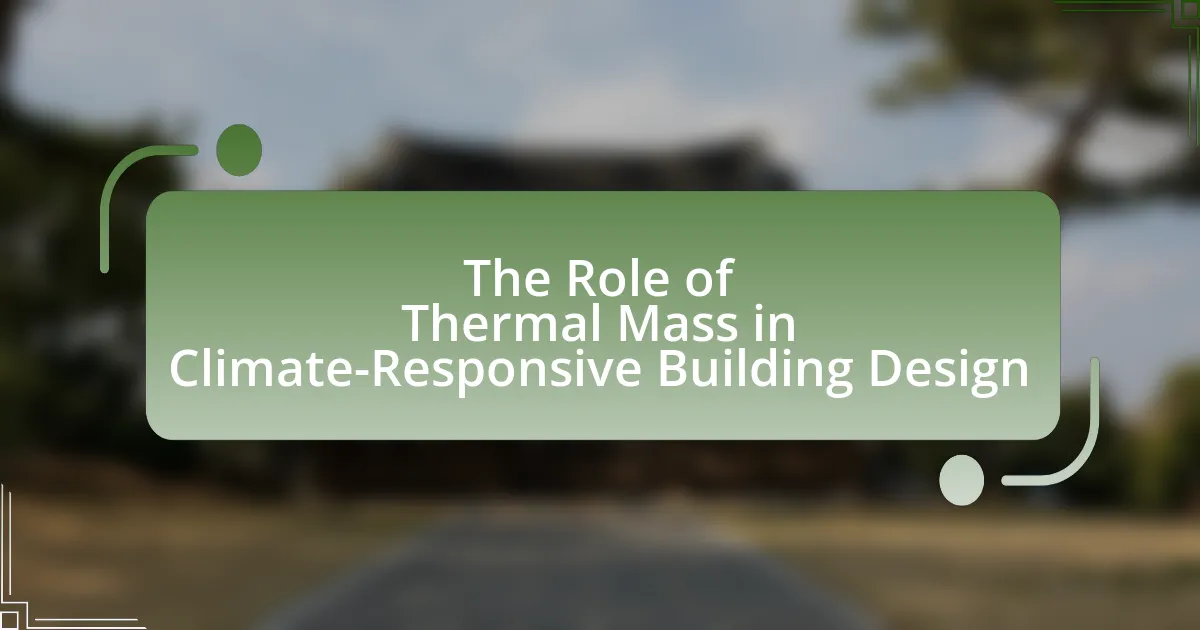Green roofs are vegetated systems installed on building rooftops that provide insulation, reduce stormwater runoff, and enhance urban biodiversity. This article explores the components and functions of green roofs, highlighting their role in mitigating urban heat islands through cooling effects and improved air quality. It discusses the benefits of integrating green roofs in urban areas, including economic advantages and biodiversity support, while also addressing the challenges of implementation, such as structural limitations and maintenance requirements. Additionally, it outlines practical steps and policies that can facilitate the adoption of green roofs in urban planning.
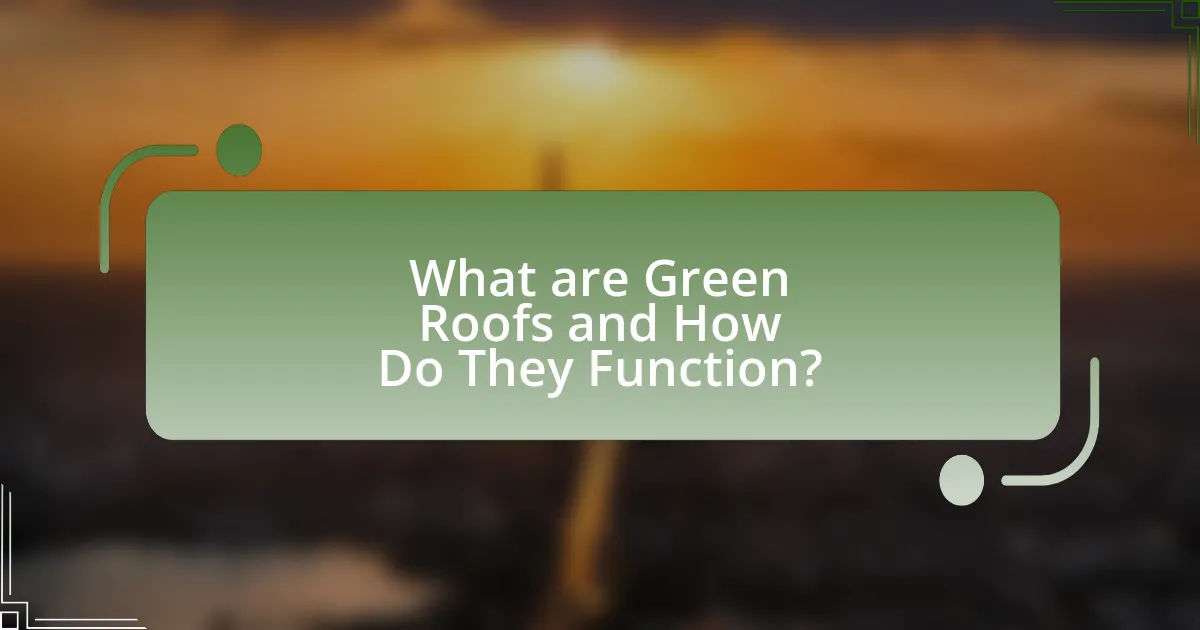
What are Green Roofs and How Do They Function?
Green roofs are vegetated systems installed on building rooftops that provide insulation, reduce stormwater runoff, and improve urban biodiversity. They function by utilizing layers of vegetation, soil, and drainage systems to absorb rainwater, which helps to cool the surrounding air through evapotranspiration. Studies indicate that green roofs can lower rooftop temperatures by up to 40% compared to conventional roofs, significantly mitigating the urban heat island effect.
What are the key components of a green roof?
The key components of a green roof include a waterproof membrane, a root barrier, drainage layers, a growing medium, and vegetation. The waterproof membrane prevents water from penetrating the building, while the root barrier protects the structure from root damage. Drainage layers facilitate excess water removal, preventing waterlogging. The growing medium, which is specially formulated soil, supports plant growth and retains moisture. Finally, vegetation, which can include various types of plants, provides the ecological benefits associated with green roofs, such as reducing urban heat and improving air quality. These components work together to create a sustainable roofing solution that mitigates urban heat islands effectively.
How do plants contribute to the effectiveness of green roofs?
Plants enhance the effectiveness of green roofs by providing insulation, reducing heat absorption, and improving stormwater management. The vegetation layer on green roofs acts as a thermal barrier, lowering indoor temperatures and reducing energy consumption for cooling. Additionally, plants absorb sunlight and reduce the urban heat island effect by reflecting and diffusing solar radiation. Research indicates that green roofs can lower surface temperatures by up to 40% compared to conventional roofs, significantly mitigating heat accumulation in urban areas. Furthermore, plants facilitate water retention, which decreases runoff and helps manage stormwater, contributing to urban sustainability.
What types of materials are used in green roof construction?
Green roof construction primarily utilizes materials such as waterproof membranes, drainage layers, growing media, and vegetation. Waterproof membranes prevent water infiltration into the building, while drainage layers facilitate excess water removal, ensuring proper moisture levels for plant health. Growing media, which consists of soil or engineered substrates, provides nutrients and support for vegetation. The vegetation itself typically includes a variety of drought-resistant plants, such as sedums and grasses, which are chosen for their ability to thrive in the specific conditions of a green roof. These materials collectively contribute to the effectiveness of green roofs in mitigating urban heat islands by enhancing insulation and promoting evapotranspiration.
How do green roofs mitigate urban heat islands?
Green roofs mitigate urban heat islands by providing vegetation that cools the surrounding environment through evapotranspiration and shading. The plants absorb sunlight and release moisture, which lowers air temperatures, while the soil layer acts as insulation, reducing heat absorption by buildings. Studies show that green roofs can reduce surface temperatures by up to 40% compared to conventional roofs, significantly decreasing the urban heat island effect.
What is the science behind the cooling effect of green roofs?
The science behind the cooling effect of green roofs lies in their ability to reduce heat absorption and enhance evapotranspiration. Green roofs consist of vegetation, soil, and a waterproof membrane, which together create a barrier that absorbs sunlight and reduces the amount of heat transferred to the building below. Studies show that green roofs can lower surface temperatures by up to 40% compared to conventional roofs, primarily due to the cooling effects of plant transpiration and soil moisture evaporation. This process not only cools the air around the building but also mitigates the urban heat island effect, where urban areas experience higher temperatures than their rural surroundings.
How do green roofs compare to traditional roofing in terms of temperature regulation?
Green roofs provide superior temperature regulation compared to traditional roofing. They achieve this by utilizing vegetation and soil, which absorb sunlight and reduce heat absorption, leading to lower surface temperatures. Studies indicate that green roofs can lower rooftop temperatures by 30 to 40 degrees Fahrenheit compared to conventional roofs, significantly mitigating the urban heat island effect. This temperature regulation is further supported by research from the National Research Council of Canada, which found that green roofs can reduce energy consumption for cooling by up to 75%.
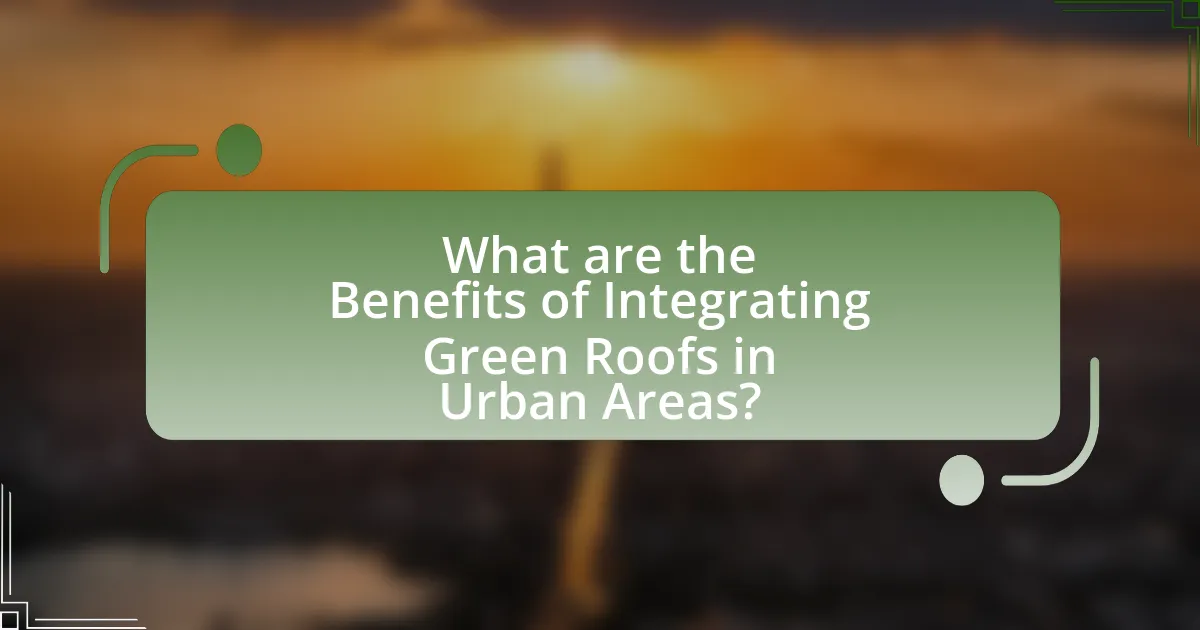
What are the Benefits of Integrating Green Roofs in Urban Areas?
Integrating green roofs in urban areas provides multiple benefits, including improved air quality, reduced urban heat island effect, and enhanced biodiversity. Green roofs help filter pollutants and carbon dioxide, leading to cleaner air; studies show that they can reduce ambient temperatures by up to 5 degrees Celsius, effectively mitigating the urban heat island effect. Additionally, these roofs create habitats for various species, promoting urban biodiversity. Research from the University of Toronto indicates that green roofs can retain up to 75% of rainfall, reducing stormwater runoff and contributing to better water management in cities.
How do green roofs improve urban biodiversity?
Green roofs improve urban biodiversity by providing habitats for various plant and animal species in densely populated areas. These green spaces create microhabitats that support pollinators, birds, and other wildlife, which are often scarce in urban environments. Research indicates that green roofs can host a diverse range of flora and fauna; for instance, a study published in the journal “Ecological Engineering” found that green roofs can support up to 30 different plant species and attract numerous insect species, enhancing local biodiversity. By increasing the availability of green spaces, green roofs contribute to ecological networks and promote species resilience in urban settings.
What species can thrive on green roofs?
Succulent plants, sedums, and native grasses are species that can thrive on green roofs. These plants are well-suited for the harsh conditions of rooftop environments, including limited soil depth, exposure to wind, and variable moisture levels. Research indicates that sedum species, such as Sedum album and Sedum spurium, are particularly effective due to their drought resistance and ability to store water. Additionally, native grasses like Bouteloua dactyloides have shown resilience in urban settings, contributing to biodiversity and ecosystem services.
How do green roofs support pollinators in urban settings?
Green roofs support pollinators in urban settings by providing essential habitats and food sources. These green spaces create diverse ecosystems that attract various pollinators, such as bees and butterflies, which are crucial for plant reproduction. Research indicates that green roofs can increase local biodiversity by offering flowering plants that bloom at different times, ensuring a continuous food supply for pollinators throughout the growing season. A study published in the journal “Urban Ecosystems” found that green roofs can host up to 30% more pollinator species compared to traditional rooftops, demonstrating their effectiveness in enhancing urban biodiversity and supporting pollinator populations.
What economic advantages do green roofs provide?
Green roofs provide significant economic advantages, including reduced energy costs, increased property value, and stormwater management savings. By insulating buildings, green roofs lower heating and cooling expenses, with studies indicating energy savings of up to 25%. Additionally, properties with green roofs often see an increase in market value, with some reports showing a rise of 15% or more. Furthermore, green roofs can reduce stormwater runoff, leading to lower costs for stormwater management and infrastructure maintenance, as they can retain up to 75% of rainfall, thereby decreasing the burden on urban drainage systems.
How can green roofs reduce energy costs for buildings?
Green roofs can reduce energy costs for buildings by providing insulation and decreasing the urban heat island effect. The vegetation and soil layers on green roofs absorb sunlight, which lowers the temperature of the building’s roof and reduces the need for air conditioning during hot months. Studies indicate that green roofs can lower indoor temperatures by up to 5 degrees Celsius, leading to energy savings of 20-30% on cooling costs. Additionally, the thermal mass of the soil retains heat in the winter, reducing heating costs. This dual benefit of insulation and temperature regulation demonstrates how green roofs effectively lower overall energy expenses for buildings.
What impact do green roofs have on property values?
Green roofs positively impact property values by increasing aesthetic appeal and providing environmental benefits. Studies indicate that properties with green roofs can see a value increase of 5% to 15% compared to similar properties without them. This increase is attributed to factors such as improved energy efficiency, reduced stormwater runoff, and enhanced urban biodiversity, which make these properties more attractive to potential buyers. Additionally, a report by the National Association of Realtors highlights that sustainable features, including green roofs, are increasingly sought after by homebuyers, further supporting the correlation between green roofs and higher property values.
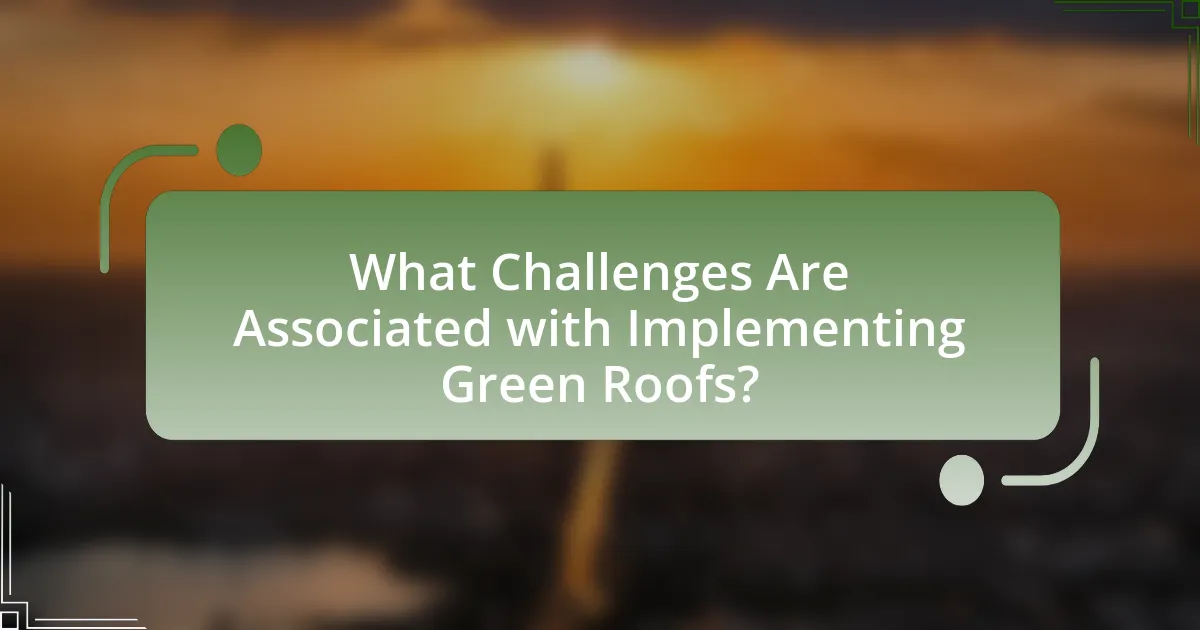
What Challenges Are Associated with Implementing Green Roofs?
Implementing green roofs presents several challenges, including structural load limitations, high initial costs, and maintenance requirements. Structural load limitations arise because green roofs add significant weight to buildings, necessitating engineering assessments to ensure that existing structures can support the additional load. High initial costs are a barrier, as the installation of green roofs can be two to three times more expensive than traditional roofing systems, which may deter property owners. Additionally, maintenance requirements, such as irrigation, weeding, and plant replacement, can complicate long-term sustainability and increase ongoing expenses. These challenges must be addressed to successfully integrate green roofs as a strategy for mitigating urban heat islands.
What are the common barriers to green roof installation?
Common barriers to green roof installation include high initial costs, structural limitations of existing buildings, and lack of awareness or knowledge among stakeholders. High initial costs can deter property owners, as installation may require significant investment in materials and labor. Structural limitations arise when buildings are not designed to support the additional weight of a green roof, necessitating costly reinforcements. Additionally, a lack of awareness or knowledge about the benefits and maintenance of green roofs can lead to resistance from property developers and owners, hindering adoption. These barriers have been documented in various studies, including a report by the National Research Council, which highlights financial and structural challenges as key obstacles to widespread green roof implementation.
How do initial costs affect the decision to install green roofs?
Initial costs significantly influence the decision to install green roofs, as higher upfront expenses can deter property owners and developers from pursuing this sustainable option. The installation of green roofs typically involves costs ranging from $10 to $25 per square foot, which can be substantially higher than traditional roofing systems. This financial barrier often leads decision-makers to prioritize immediate economic considerations over long-term environmental benefits, such as energy savings and stormwater management. Studies indicate that while green roofs can reduce energy costs by up to 25% and extend roof lifespan, the initial investment remains a critical factor in the decision-making process.
What maintenance requirements do green roofs entail?
Green roofs require regular maintenance to ensure their health and functionality. This maintenance includes tasks such as irrigation, weeding, fertilization, and monitoring plant health. Specifically, irrigation is crucial during dry periods to prevent plant stress, while weeding helps control invasive species that can outcompete desired vegetation. Fertilization is necessary to replenish nutrients in the growing medium, and monitoring plant health allows for early detection of pests or diseases. Studies indicate that proper maintenance can extend the lifespan of green roofs and enhance their benefits, such as stormwater management and urban heat reduction.
How can these challenges be overcome?
To overcome the challenges of integrating green roofs to mitigate urban heat islands, municipalities can implement supportive policies and provide financial incentives for green roof installations. Research indicates that cities with financial subsidies for green infrastructure see a higher adoption rate, as evidenced by a study from the University of Toronto, which found that financial incentives increased green roof installations by 30% in urban areas. Additionally, public awareness campaigns can educate property owners about the benefits of green roofs, such as energy savings and improved air quality, further encouraging adoption.
What funding options are available for green roof projects?
Funding options for green roof projects include government grants, tax incentives, and private financing. Various federal and state programs, such as the Environmental Protection Agency’s Green Infrastructure Grant Program, provide financial support specifically for green infrastructure projects, including green roofs. Additionally, local municipalities may offer rebates or incentives to encourage the installation of green roofs, recognizing their benefits in reducing urban heat islands and improving stormwater management. Non-profit organizations and private investors also contribute funding through grants and investment opportunities aimed at sustainable urban development.
What best practices can ensure successful green roof implementation?
Successful green roof implementation requires careful planning, appropriate plant selection, and proper maintenance. Effective planning involves assessing structural load capacity, ensuring adequate waterproofing, and designing for drainage to prevent water accumulation. Selecting native and drought-resistant plants enhances sustainability and reduces maintenance needs, as these species are better adapted to local climates. Regular maintenance, including irrigation, weeding, and monitoring plant health, is essential to ensure the longevity and effectiveness of the green roof. Studies show that well-maintained green roofs can reduce urban heat island effects by lowering surface temperatures and improving air quality, thus validating the importance of these best practices.
What are practical steps for integrating green roofs in urban planning?
Practical steps for integrating green roofs in urban planning include establishing supportive policies, conducting feasibility studies, and providing financial incentives. Supportive policies can be implemented through zoning regulations that encourage or require green roofs in new developments, as seen in cities like Toronto, which mandates green roofs on certain buildings. Conducting feasibility studies helps assess structural capacity and environmental benefits, ensuring that green roofs are suitable for specific urban contexts. Financial incentives, such as grants or tax rebates, can motivate developers to invest in green roofs, as demonstrated by programs in Chicago that have successfully increased green roof installations.
How can city policies support the adoption of green roofs?
City policies can support the adoption of green roofs by implementing incentives such as tax breaks, grants, and subsidies for property owners who install them. These financial incentives encourage investment in green roofs, which can reduce urban heat islands by lowering surface temperatures and improving air quality. For instance, cities like Toronto have successfully used a combination of financial incentives and regulatory frameworks to promote green roof installations, resulting in over 1.5 million square feet of green roofs by 2020. Additionally, policies can mandate green roofs in new developments or major renovations, further integrating them into urban planning and contributing to climate resilience.
What role do community engagement and education play in promoting green roofs?
Community engagement and education are crucial in promoting green roofs by fostering awareness and encouraging participation among residents and stakeholders. Engaging the community helps to build support for green roof initiatives, as informed citizens are more likely to advocate for sustainable practices. Educational programs can demonstrate the environmental benefits of green roofs, such as reducing urban heat islands, improving air quality, and enhancing biodiversity. For instance, studies show that cities with active community involvement in green infrastructure projects see higher adoption rates and maintenance of such systems, leading to long-term sustainability and resilience against climate change.
